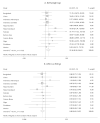Multiple micronutrient supplementation during pregnancy in low-income countries: a meta-analysis of effects on birth size and length of gestation
- PMID: 20120795
- PMCID: PMC3541502
- DOI: 10.1177/15648265090304S408
Multiple micronutrient supplementation during pregnancy in low-income countries: a meta-analysis of effects on birth size and length of gestation
Abstract
Background: Multiple micronutrient deficiencies are common among women in low-income countries and may adversely affect pregnancy outcomes.
Objective: This meta-analysis reports the effects on newborn size and duration of gestation of multiple micronutrient supplementation mainly compared with iron plus folic acid during pregnancy in recent randomized, controlled trials.
Methods: Original data from 12 randomized, controlled trials in Bangladesh, Burkina Faso, China, Guinea-Bissau, Indonesia, Mexico, Nepal, Niger, Pakistan, and Zimbabwe, all providing approximately 1 recommended dietary allowance (RDA) of multiple micronutrients to presumed HIV-negative women, were included. Outcomes included birthweight, other birth measurements, gestation, and incidence of low birthweight (LBW) (< 2500 g), small-for-gestational age birth (SGA, birthweight below the within-each-population 10th percentile), large-for-gestational age birth (LGA, birthweight above the within-each-population 90th percentile), and preterm delivery (< 37 weeks).
Results: Compared with control supplementation (mainly with iron-folic acid), multiple micronutrient supplementation was associated with an increase in mean birthweight (pooled estimate: +22.4 g [95% CI, 8.3 to 36.4 g]; p = .002), a reduction in the prevalence of LBW (pooled OR = 0.89 [95% CI, 0.81 to 0.97]; p = .01) and SGA birth (pooled OR = 0.90 [95% CI, 0.82 to 0.99]; p = .03), and an increase in the prevalence of LGA birth (pooled OR = 1.13 [95% CI, 1.00 to 1.28]; p = .04). In most studies, the effects on birthweight were greater in mothers with higher body mass index (BMI). In the pooled analysis, the positive effect of multiple micronutrients on birthweight increased by 7.6 g (95% CI, 1.9 to 13.3 g) per unit increase in maternal BMI (p for interaction = .009). The intervention effect relative to the control group was + 39.0 g (95% CI, +22.0 to +56.1 g) in mothers with BMI of 20 kg/m2 or higher compared with -6.0 g (95% CI, -8.8 to +16.8 g) in mothers with BMI under 20 kg/m2. There were no significant effects of multiple micronutrient supplementation on birth length or head circumference nor on the duration of gestation (pooled effect: +0.17 day [95% CI, -0.35 to +0.70 day]; p = .51) or the incidence of preterm birth (pooled OR = 1.00 [95% CI, 0.93 to 1.09]; p = .92).
Conclusions: Compared with iron-folic acid supplementation alone, maternal supplementation with multiple micronutrients during pregnancy in low-income countries resulted in a small increase in birthweight and a reduction in the prevalence of LBW of about 10%. The effect was greater among women with higher BMI.
Figures








References
-
- De Onis M, Blossner M, Villar J. Levels and patterns of intra-uterine growth retardation in developing countries. Eur J Clin Nutr. 1998;52(suppl 1):S5–15. - PubMed
-
- Ashworth A. Effects of intrauterine growth retardation on mortality and morbidity in infants and children. Eur J Clin Nutr. 1998;52(suppl 1):S34–42. - PubMed
-
- Goldenberg RL, Hoffman HJ, Cliver SP. Neurodevelopmental outcome of small-for-gestational-age infants. Eur J Clin Nutr. 1998;52(suppl 1):S54–8. - PubMed
-
- Barker DJP. Mothers, babies and health in later life. Churchill Livingstone; Edinburgh, UK: 1998.
Publication types
MeSH terms
Substances
Grants and funding
LinkOut - more resources
Full Text Sources
Medical

